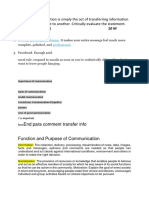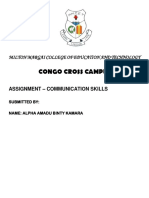Communication
Communication
Uploaded by
Leenas MagnaCopyright:
Available Formats
Communication
Communication
Uploaded by
Leenas MagnaCopyright
Available Formats
Share this document
Did you find this document useful?
Is this content inappropriate?
Copyright:
Available Formats
Communication
Communication
Uploaded by
Leenas MagnaCopyright:
Available Formats
Communication
Communication is the process of transmitting information, ideas, thoughts, feelings, and messages
between individuals or groups. It is essential for human interaction and plays a crucial role in every
aspect of our lives, from personal relationships to business transactions and global diplomacy.
Key Elements of Communication
1. Sender : The person or entity who initiates the communication by encoding a message. This
can be verbal (spoken words) or non-verbal (body language, gestures).
2. Message : The information, ideas, or emotions being transmitted by the sender. It can be
conveyed through various mediums such as speech, writing, visuals, or technology.
3. Channel : The medium through which the message is transmitted. This can include face-to-
face conversation, telephone calls, emails, letters, social media, etc.
4. Receiver : The person or group for whom the message is intended. They decode the message
to understand its meaning.
5. Feedback : The response or reaction from the receiver back to the sender. Feedback can be
verbal or non-verbal and helps ensure that communication is effective and understood.
Types of Communication
- Verbal Communication : Involves the use of spoken or written words. It includes face-to-face
conversations, phone calls, presentations, speeches, emails, letters, etc.
- Non-Verbal Communication : This includes body language, facial expressions, gestures,
posture, eye contact, and other forms of communication that do not involve spoken or written
words but convey meaning.
- Visual Communication : Involves the use of visual elements such as graphs, charts, diagrams,
maps, symbols, and images to convey information.
- Written Communication : Involves the use of written words to transmit information. It
includes emails, letters, reports, memos, articles, etc.
Importance of Communication
Effective communication is crucial for several reasons:
- Building Relationships : It fosters understanding, trust, and respect in personal and
professional relationships.
- Information Sharing : It enables the exchange of information, ideas, and knowledge,
facilitating decision-making and problem-solving.
- Conflict Resolution : Good communication helps in resolving conflicts and misunderstandings
by promoting clarity and understanding.
- Achieving Goals : It ensures that tasks are completed efficiently and goals are achieved by
aligning efforts and coordinating actions.
- Influence and Persuasion : Effective communicators can influence and persuade others,
whether in negotiations, sales, leadership, or advocacy.
Barriers to Effective Communication
- Physical Barriers : Distance, noise, and physical obstructions that interfere with
communication.
- Semantic Barriers : Differences in language, jargon, and meaning that lead to
misunderstandings.
- Psychological Barriers : Prejudices, emotions, and stereotypes that affect how messages are
perceived.
- Cultural Barriers : Differences in cultural norms, values, and communication styles that
impact understanding.
Improving Communication Skills
- Active Listening : Paying full attention to the speaker and understanding their message before
responding.
- Clarity and Conciseness : Using clear and simple language to convey messages effectively.
- Non-Verbal Cues : Being aware of and using appropriate body language, gestures, and facial
expressions.
- Feedback : Encouraging and providing feedback to ensure mutual understanding.
- Empathy : Understanding and considering the emotions and perspectives of others in
communication.
In summary, effective communication is fundamental to human interaction and success in various
aspects of life. By understanding its elements, types, importance, barriers, and ways to improve,
individuals and organizations can enhance their communication skills and achieve better outcomes.
You might also like
- Values 9 ModuleDocument4 pagesValues 9 ModuleFerin the EggNo ratings yet
- Ritu HWDocument15 pagesRitu HWStuti KapoorNo ratings yet
- Communication Skills AssignmentDocument4 pagesCommunication Skills AssignmentAbdul Karim KamaraNo ratings yet
- Introduction To Communication SkillsDocument2 pagesIntroduction To Communication SkillsPõìSÕñNo ratings yet
- Note 2024-02-29 00-24-16Document12 pagesNote 2024-02-29 00-24-16mohammadiadel188No ratings yet
- Soft Skill - MergedDocument65 pagesSoft Skill - Mergedvinay kumarNo ratings yet
- Oral Comm - EnglishDocument10 pagesOral Comm - EnglishHILVANO, HEIDEE B.No ratings yet
- Jessa Mae V. Mogas BSN Ii-B: What Is Communication?Document6 pagesJessa Mae V. Mogas BSN Ii-B: What Is Communication?yhana paredesNo ratings yet
- A Report On Effective Communication, Its Types and Barriers & Top 5 Effective Communication Skills For Project ManagersDocument16 pagesA Report On Effective Communication, Its Types and Barriers & Top 5 Effective Communication Skills For Project ManagersShruti DhawanNo ratings yet
- Topic 1 Introduction To CommunicationsDocument11 pagesTopic 1 Introduction To Communicationsgalmajillo11No ratings yet
- Business Communication NotesDocument8 pagesBusiness Communication Notesvivekbhartiofficial11No ratings yet
- Purposive Communication Module 1Document6 pagesPurposive Communication Module 1hank9169No ratings yet
- PCS Unit 1Document7 pagesPCS Unit 1anugya2727No ratings yet
- Business Communication: Presented By: Akshay Malik Dikshant Karan Chhikara Nishtha Jain Shivam GuptaDocument35 pagesBusiness Communication: Presented By: Akshay Malik Dikshant Karan Chhikara Nishtha Jain Shivam GuptaNishtha JainNo ratings yet
- TYPES OF COMMUN-WPS OfficeDocument4 pagesTYPES OF COMMUN-WPS Officealexapodadera4No ratings yet
- Types of CommunicationDocument27 pagesTypes of Communicationsthakur101291No ratings yet
- Communication ProcessDocument24 pagesCommunication ProcessafsalafiftzNo ratings yet
- Communication Skills - Sep 2019Document153 pagesCommunication Skills - Sep 2019goodpromise.medicalNo ratings yet
- Communication Skills - Sep 2019Document82 pagesCommunication Skills - Sep 2019e70760279No ratings yet
- Communication 1stDocument8 pagesCommunication 1stnehagupta4915No ratings yet
- CE For I Sem BTechDocument10 pagesCE For I Sem BTechkskskNo ratings yet
- Oral Communication, Written Communication: Message SenderDocument8 pagesOral Communication, Written Communication: Message SenderATHIRA MOHANNo ratings yet
- CLM 100 Development of Communications - Books FDocument16 pagesCLM 100 Development of Communications - Books FCollins OtienoNo ratings yet
- Business Communication Sir ProvidedDocument57 pagesBusiness Communication Sir Providedimranahmed4uNo ratings yet
- Unit 1 Managerial CommunicationDocument34 pagesUnit 1 Managerial CommunicationGamers 4 lyfNo ratings yet
- Co CurricularDocument5 pagesCo Curriculartannugupta208No ratings yet
- Bam 006-Module 1-8Document8 pagesBam 006-Module 1-8cassofia169No ratings yet
- Kyle Trisha Angela T. Matias Elements of CommunicationDocument5 pagesKyle Trisha Angela T. Matias Elements of CommunicationAnj MatiasNo ratings yet
- CommunicationDocument4 pagesCommunicationkhatuenterpriseskNo ratings yet
- Purposive CommunicationDocument31 pagesPurposive CommunicationPaul Jordan MalateNo ratings yet
- Unit 1 CommunicationDocument9 pagesUnit 1 Communicationtanu99n89No ratings yet
- CommunicationDocument10 pagesCommunicationkedeancampbell215No ratings yet
- Note 2024-02-29 00-24-16Document26 pagesNote 2024-02-29 00-24-16mohammadiadel188No ratings yet
- Effective Communication 1Document4 pagesEffective Communication 1V. Kavi ArasanNo ratings yet
- Review Material For Midterm ExamDocument11 pagesReview Material For Midterm ExamKyLa CeriaLes ÜNo ratings yet
- English & Professional Communication - Unit-2Document6 pagesEnglish & Professional Communication - Unit-2Soham DasNo ratings yet
- Note 2024-02-29 00-24-16Document22 pagesNote 2024-02-29 00-24-16mohammadiadel188No ratings yet
- Chencha Construction and Industrial COLLEGE Database Administration (Level III)Document16 pagesChencha Construction and Industrial COLLEGE Database Administration (Level III)Galaxy teckNo ratings yet
- Lesson 1 OutlineDocument5 pagesLesson 1 OutlineXHYRICH ISLETANo ratings yet
- Communication: DefinitionDocument4 pagesCommunication: DefinitionPratyush ChoubeyNo ratings yet
- Communication Skills ExamDocument33 pagesCommunication Skills Exammalware100% (1)
- All About Purposive CommunicationDocument20 pagesAll About Purposive CommunicationAnna SwiftNo ratings yet
- Unit - Iii - ObDocument33 pagesUnit - Iii - ObSimeonNischithNo ratings yet
- Purcom - HandoutDocument19 pagesPurcom - HandoutAshNo ratings yet
- GNS 102 - COMMU-WPS OfficeDocument4 pagesGNS 102 - COMMU-WPS Officelawanyahaya21No ratings yet
- Purposive Communication FinalDocument67 pagesPurposive Communication Finalentisar MaladoNo ratings yet
- Lesson 1 Fundamentals of CommunicationDocument9 pagesLesson 1 Fundamentals of Communicationsanicyril7No ratings yet
- Unit - 1 Business Communication - FYBBA Sem-1 - GeneralDocument28 pagesUnit - 1 Business Communication - FYBBA Sem-1 - Generalpmeet8074No ratings yet
- UNIT - I Communication SkillsDocument6 pagesUNIT - I Communication Skillsanand shuklaNo ratings yet
- E-Platform-Content Communication KNCDocument52 pagesE-Platform-Content Communication KNCAtrap GonzalezNo ratings yet
- Purposive COmm Topic 1Document33 pagesPurposive COmm Topic 1blaireNo ratings yet
- Communication SkillsDocument61 pagesCommunication SkillsiammathetaNo ratings yet
- Bca First Sem CommunicationDocument42 pagesBca First Sem CommunicationtarunNo ratings yet
- Av Aids File - FinalDocument58 pagesAv Aids File - FinalSindhu S NairNo ratings yet
- Communication Process and Its Types (MGM)Document13 pagesCommunication Process and Its Types (MGM)anjalikumarisah518No ratings yet
- Eng3a Midterm ReviewerDocument22 pagesEng3a Midterm Reviewerkate Lorraine yabutNo ratings yet
- Oromia Police CollegeDocument20 pagesOromia Police CollegeChala BekeleNo ratings yet
- 1-Communication TypesDocument10 pages1-Communication TypesS.m. ChandrashekarNo ratings yet
- Chapter One SkillsDocument17 pagesChapter One Skillstalex0628No ratings yet
- Inbound 7797089833344847880Document3 pagesInbound 7797089833344847880picdat1k2No ratings yet
- Listen, Speak, Lead: Elevate Your Success with Effective CommunicationFrom EverandListen, Speak, Lead: Elevate Your Success with Effective CommunicationNo ratings yet
- CSC 201 Project ReportDocument14 pagesCSC 201 Project ReportihsaanaasifNo ratings yet
- Kanarev Water EnergyDocument11 pagesKanarev Water EnergyharishkumarsinghNo ratings yet
- I04 Reading Quiz - C (Copia)Document3 pagesI04 Reading Quiz - C (Copia)AlphonseNo ratings yet
- Cervical Sympathetic Chain Ganglioneuroma: Case Report and Review of LiteratureDocument4 pagesCervical Sympathetic Chain Ganglioneuroma: Case Report and Review of LiteratureIOSR Journal of PharmacyNo ratings yet
- My Roses: Jovie PunzalanDocument4 pagesMy Roses: Jovie PunzalanJziki LokovaniakNo ratings yet
- Space Radiation Effects in Electronic ComponentsDocument50 pagesSpace Radiation Effects in Electronic Componentsnewton400No ratings yet
- Case ReportDocument16 pagesCase ReportSabbir ThePsychoExpressNo ratings yet
- Term Paper Assignment For Advanced Auditing and EDPDocument3 pagesTerm Paper Assignment For Advanced Auditing and EDPHabte Debele0% (1)
- Issue 2Document347 pagesIssue 2HJ ManviNo ratings yet
- GENERAL DIRECTIONS: READ, ANALYZE, and ANSWER The 45-Item Multiple ChoiceDocument8 pagesGENERAL DIRECTIONS: READ, ANALYZE, and ANSWER The 45-Item Multiple ChoiceAllenmay LagorasNo ratings yet
- SNICKERS Hungerithm: Case NotesDocument5 pagesSNICKERS Hungerithm: Case NotesJacob SibbaldNo ratings yet
- Asm 8424Document1 pageAsm 8424Aryan MurghaiNo ratings yet
- Lecture 32Document40 pagesLecture 32Abdesselem BoulkrouneNo ratings yet
- 5 JC 5342Document2 pages5 JC 5342Manjunatha EikilaNo ratings yet
- Bow City Alberta HistoryDocument9 pagesBow City Alberta HistoryJonathan KochNo ratings yet
- Impact of Business Communication On Organizational Performance in Nigerian CompaniesDocument1 pageImpact of Business Communication On Organizational Performance in Nigerian CompaniesJayakar GadiNo ratings yet
- Arseny TarkovskyDocument9 pagesArseny TarkovskyGazeta_int100% (2)
- Full TextDocument90 pagesFull TextBea DiloyNo ratings yet
- Ahle Bait Fil QuranDocument264 pagesAhle Bait Fil QuranSWHRZ'sNo ratings yet
- APA - 11.1 User Guide - Cazbug00Document880 pagesAPA - 11.1 User Guide - Cazbug00Aladar AladarNo ratings yet
- Nursing Care Plan2 CVADocument4 pagesNursing Care Plan2 CVAhermesdave1No ratings yet
- Concept and Advantages of Clasification and Codification of Materials - Accounting-ManagementDocument3 pagesConcept and Advantages of Clasification and Codification of Materials - Accounting-ManagementBishnu S. MukherjeeNo ratings yet
- Ultimate Price Action 2.0 - Day 2Document70 pagesUltimate Price Action 2.0 - Day 2nazimvmNo ratings yet
- Course: General Science (6404) Assignment 1 Q.1 How Science and Technology Affect Each Other? Also Elaborate Effect of Science and Technology On Society. Science and Technology Affect Each OtherDocument19 pagesCourse: General Science (6404) Assignment 1 Q.1 How Science and Technology Affect Each Other? Also Elaborate Effect of Science and Technology On Society. Science and Technology Affect Each Othersyed rahmanNo ratings yet
- Paper WasteDocument2 pagesPaper WastepramxxxNo ratings yet
- PCGG Vs PeñaDocument2 pagesPCGG Vs PeñaTaper Garcia100% (1)
- Tutorial 6 Civil Engineering Project & Cost ManagementDocument3 pagesTutorial 6 Civil Engineering Project & Cost ManagementFearless HeroNo ratings yet
- Brain Blood SupplyDocument28 pagesBrain Blood SupplyYIKI ISAACNo ratings yet
- ICSE - History & Civics Sample Paper-1-solution-Class 10 Question PaperDocument9 pagesICSE - History & Civics Sample Paper-1-solution-Class 10 Question PaperFirdosh Khan100% (1)

























































































